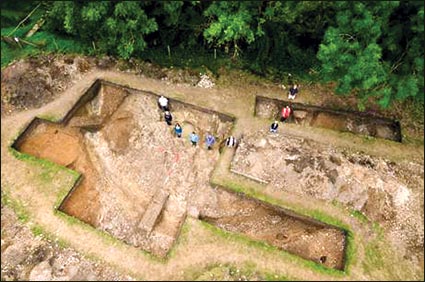Mini-Stonehenge found
Crematorium on Stonehenge road :
James Owen National Geographic News
Sorry, Spinal Tap fans, though a newfound stone circle in England is
being called a mini-Stonehenge, it was never in danger of being crushed
by a dwarf. Perhaps a prehistoric crematorium, 33-foot-wide
(10-meter-wide) ‘Bluestonehenge’ was discovered just over a mile (1.6
kilometers) from the original Stonehenge in Salisbury, United Kingdom,
scientists announced a few days ago.
The 5,000-year-old ceremonial site is thought to have been a key stop
along an ancient route between a land of the living, several miles away
and a domain of the dead, Stonehenge.
|

Standing in some of the prehistoric holes where four-ton stones
rose at Bluestonehenge roughly 5,000 years ago, members of the
Stonehenge River Project archaeology team form a semicircle amid
hard-angled excavation plots in late 2009. - Photograph courtesy
Adam Stanford/Aerial-Cam |
Named for the color of its long-gone stones, Bluestonehenge, or
Bluehenge, was dismantled thousands of years ago, and many of its
standing stones were integrated into Stonehenge during a rebuilding of
the larger monument, according to the archaeologists.
Mini-Stonehenge: Prehistoric Crematorium?
Bluestonehenge was found in August along the banks of the River Avon
during excavations led by Mike Parker Pearson of the University of
Sheffield in the UK.
The circle of an estimated 25 bluestones was surrounded by a henge,
an earthwork with a ditch and bank. The henge has been tentatively dated
to 2400 BC, but flint arrowheads found at the stone-circle site indicate
the rocks were erected as early as 3000 BC.
More precise dates will have to wait until prehistoric deer antlers,
used as pickaxes at Bluestonehenge, have been radiocarbon dated, the
team said.
Made from a hard dolerite rock, the four-ton megaliths were hewn from
ancient quarries in the Preseli Mountains of Wales, 150 miles (240
kilometers) away, Parker Pearson said. The manpower and logistics
required to transport the stones suggests they had deep significance to
ancient Britons, experts say.
Unlike Stonehenge, which aligns with the sun at the summer and winter
solstices, Bluestonehenge shows no sign of a particular orientation, or
even an entrance, the team reported. Nor is there any evidence that
people lived at the site.
There’s no pottery, animal bones, ornaments, or relics such as those
unearthed at the nearby Stone Age village of Durrington Walls, found
near Stonehenge in 2007.
However , Bluestonehenge’s empty stone holes were filled with
charcoal, indicating that large amounts of wood were burned there,
signifying, perhaps, a prehistoric crematorium. Perhaps not
coincidentally, ashes have been found in holes at Stonehenge.
“Maybe the bluestone circle is where people were cremated before
their ashes were buried at Stonehenge itself”, Parker Pearson said in a
statement.
Parker Pearson proposes that Stonehenge represented a ‘domain of the
dead’ to ancestor-worshiping ancient Britons.
“It could be that Bluestonehenge was where the dead began their final
journey to Stonehenge”, he added. “Not many people know that Stonehenge
was Britain’s largest burial ground at that time”.
The Bluestonehenge discovery was made as part of the Stonehenge
Riverside Project, a seven-year archaeological investigation of the
Stonehenge area, supported by the National Geographic Society’s
Committee for Research and Exploration.
Key Piece in Stonehenge Puzzle
Bluestonehenge represents a vital part of the jigsaw as researchers
slowly piece together the meaning of Stonehenge, Parker Pearson
believes.
The team now believes Stonehenge incorporates the 25 bluestones that
originally stood at Bluestonehenge. Only a few bluestone pieces were
found at the new site, and “that is telling you that the stones are
being taken out whole”, said dig co-director Julian Thomas of the
University of Manchester.
Bluestonehenge’s stones were dragged along the avenue to Stonehenge
during a major rebuilding phase around 2500 BC, the archaeologists
speculated (time line of the stages of Stonehenge).
If Bluestonehenge had been demolished much later, in Roman times,
when reverence for the stones would have been diminished, for example,
“they’d be breaking them up and turning them into building stone”,
Thomas said.
“I think it’s very likely that the new stone circle is contemporary
with the very earliest stages of Stonehenge”, the archaeologist added.
Pit stop on route to afterlife
Parker Pearson sees Bluestonehenge’s location, on the river and at
the beginning of a 1.75 mile (2.8 kilometer) earthen avenue leading to
Stonehenge, as highly significant. Previous excavations have drawn a
picture of seasonal festivities at Durrington Walls, which some see as
part of the ‘domain of the living’ in the spiritual geography of the
people of Stonehenge.
The dead would be celebrated at Durrington, then carried along a
short avenue to the River Avon, archaeologists speculate. The procession
would continue down the river, then ‘dock’ at the foot of the avenue
leading to Stonehenge, stopping, it’s now thought, at Bluestonehenge,
perhaps for cremation, before continuing to Stonehenge for burial.
Whatever Bluestonehenge’s role along the route was, ‘it emphasizes
the connection with the whole monumental complex”, Thomas, of the
University of Manchester, said.
“We tend to think of monuments as cultural, and a river or a mountain
as something that’s natural”, he added. “What’s fascinating about the
Stonehenge complex is that these different elements are being threaded
together”.
“By constructing these monuments you’re not just adding a cultural
veneer on the surface, you’re actually reengineering the world”.
|



